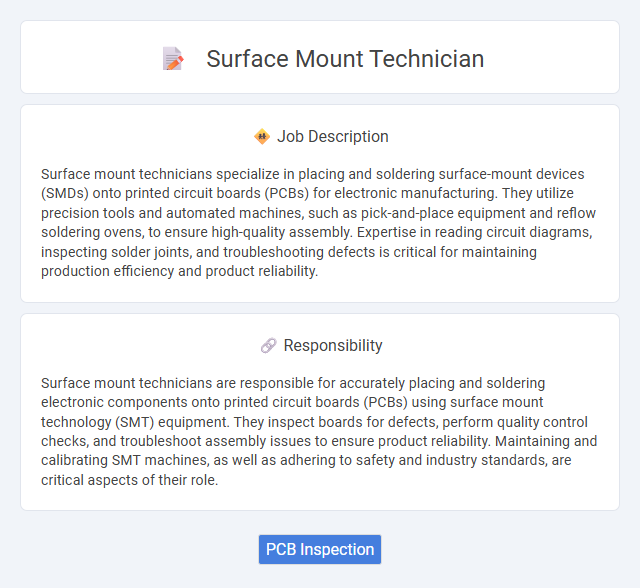
Surface mount technicians specialize in placing and soldering surface-mount devices (SMDs) onto printed circuit boards (PCBs) for electronic manufacturing. They utilize precision tools and automated machines, such as pick-and-place equipment and reflow soldering ovens, to ensure high-quality assembly. Expertise in reading circuit diagrams, inspecting solder joints, and troubleshooting defects is critical for maintaining production efficiency and product reliability.
Individuals with strong attention to detail and good hand-eye coordination are probably well-suited for the role of a Surface Mount Technician, as the job requires precise placement and soldering of electronic components. Those who prefer repetitive, focused tasks and can stand or sit for extended periods might find this work environment compatible with their skills and stamina. People who struggle with fine motor skills or have difficulty maintaining concentration may face challenges in fulfilling the responsibilities effectively.
Qualification
Surface mount technicians must possess strong proficiency in reading electronic schematics and technical blueprints to accurately place components on printed circuit boards (PCBs). Essential qualifications include hands-on experience with automated optical inspection (AOI) machines, soldering skills, and familiarity with surface mount technology (SMT) equipment calibration and maintenance. Certifications such as IPC-A-610 or J-STD-001 offer a competitive edge by validating expertise in soldering standards and electronic assembly quality.
Responsibility
Surface mount technicians are responsible for accurately placing and soldering electronic components onto printed circuit boards (PCBs) using surface mount technology (SMT) equipment. They inspect boards for defects, perform quality control checks, and troubleshoot assembly issues to ensure product reliability. Maintaining and calibrating SMT machines, as well as adhering to safety and industry standards, are critical aspects of their role.
Benefit
Surface mount technician jobs likely offer benefits such as competitive salaries and opportunities for skill development in electronics manufacturing. Employees may experience job stability due to the growing demand for electronic devices and automated production. Health insurance and paid time off could also be part of standard compensation packages in this field.
Challenge
Surface mount technician roles likely involve intricate challenges related to precise placement and soldering of tiny electronic components on circuit boards. The job probably requires exceptional attention to detail and steady hands to avoid defects or malfunctions. Troubleshooting and adapting to evolving technologies may also present continual difficulties in this field.
Career Advancement
Surface mount technicians with expertise in SMT assembly and PCB soldering can advance into roles such as process engineers, quality control inspectors, or production supervisors. Mastery of automated equipment programming and troubleshooting improves promotion prospects within electronics manufacturing companies. Continuous skill development in component placement technologies and defect analysis supports long-term career growth in high-tech industries.
Key Terms
PCB Inspection
Surface mount technicians specializing in PCB inspection play a critical role in ensuring the quality and reliability of printed circuit boards by identifying defects such as soldering issues, component misalignment, and missing parts. Proficient in using automated optical inspection (AOI) systems and X-ray inspection tools, these technicians analyze complex PCB assemblies to detect micro-level faults. Their expertise directly contributes to minimizing production errors and enhancing the overall performance of electronic devices.
 kuljobs.com
kuljobs.com